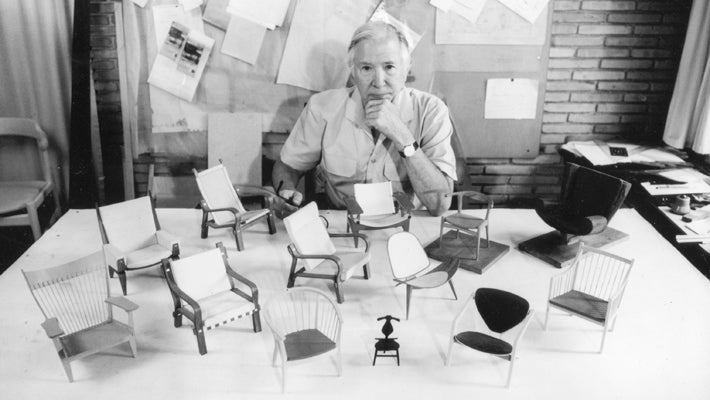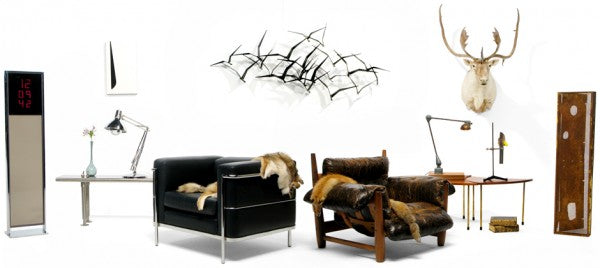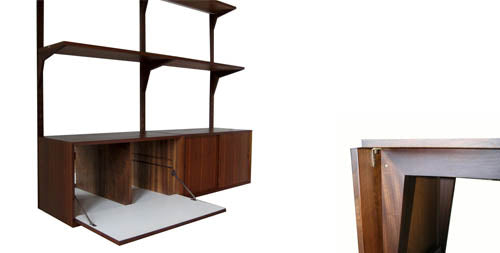Hans J. Wegner
The works of Danish born architect and furniture designer, Hans Jørgen Wegner, exhibit a love of natural materials and a studied understanding of the necessity of furniture as a marriage of function and beauty.
In his youth, Wegner developed an affinity for the material properties of wood, working as an apprentice to respected cabinetmaker H.F. Stahlberg. This experience instilled in Wegner an understanding of the tectonics and craft of traditional Danish carpentry. This understanding of workmanship was supplement with a formal design education when Wegner entered the Copenhagen School of Arts & Crafts in his early twenties. After receiving his architectural degree in 1938 he began working with renown Danish designers Arne Jacobsen and Erick Møller before establishing his own practice in 1943.
Throughout his career Hans Wegner was responsible for over 500 unique chair designs, making him the most prolific Danish designer to date. Perhaps his most well known design, the Round Chair, gained international notoriety in 1949 when Interiors magazine declared it “the world’s most beautiful chair”. The beauty of Wegner’s genius is seen in his designs as the manifestation of a remarkable combination of designer and craftsmen.
Get This Look
Black & Chrome $5345
Howard Miller Clock - $1495
Stainless Locker Room Bench - $675
Jack Cartwright 20/123 Club Chair - $1433
L-1 Luxo Light - $287
Sterling Silver Candle Holders - $55
CP Price Black and White Relief 2 Piece Painting - $1400 (coming soon to shop)
*Coming Soon* Bud Vase, Jere Bird Sculpture, & Coyote Pelt
Brown & Brass $19,654
Sergio Rodrigues Mole Chair - $12,745 (pair)
Peter Hvidt Interlocking Tables - $4245 (set of 6)
Caribou - $1869
Articulating Industrial Work Lamp - $795
*Coming Soon* Mesh box, Antique Books, Pelt, & Lab Set.
- The Good Mod
- Tags: All the News Inspiration
Mario Botta
Born in Mendrisio, Switzerland in 1943, Botta trained as a technical draftsman before attending art school in Milan. From 1965 to 1969 he studied under Carlo Scarpa at the Institute University of Architecture in Venice. In this same period he was also an assistant to Louis I. Kahn and LeCorbusier. Botta then proceeded to open his own practice in Lugano, Switzerland (1970). Botta built exclusively in Switzerland during his early career, gaining international acclaim for such buildings as; the Capuchin convent in Lugano, the Craft Centre in Balerna, and the Administration Building for the Staatsbank in Fribourg.
Many of Botta's projects have been single-family houses. For him, the single-family house includes the problems and the objectives of the entire discipline of architecture. Carrying on the ideas of Kahn, Mario Botta believes in the organization of the relationship between man and nature and the distinctive characterization of man in relationship to his own environment. Botta is keenly interested in history and in the study of man's habitat through time. Because the home has been the one constant through the evolution of history, he feels this architectural type deserves both study and elaboration. It is not only individual needs, but also the collective requirements of societies that fascinate him. Another theme pervading his single-family houses is the search for the roots of a design and man's identity in a particular place. Cultural traditions are important throughout his projects, and his forms are derived from - but not copied from - "the environment as a testimony of history and memory". Because of this Botta is often identified with the Italian neo-rationalist group, Tendenza. The houses he designed during the early 1970s established the Ticino school and changed Swiss architecture dramatically. In the 1980's he secured international commissions such as the Museum of Modern Art in San Francisco, California. During this time (1980s) he designed for Alias. Botta’s innovative work has inspired and promoted a generation of Swiss architects who are internationally acclaimed.
Sources: architect.architecture.sk http://www.bookrags.com/tandf/botta-mario-1943-tf/ http://www.botta.ch/Page/Recenti_en.php
Joe Colombo
What do you get when you mix the Nuclear Painting Movement and the Concret Art Group, along with sculptures, electric appliances, plastics, and Italy? Well, pretty awesome furniture, and Joe Colombo. In Milan, Italy, Colombo was raised along with two brothers. Their father owned a electric appliance factory. He chose to go to school to study science, but quickly changed over to art. Colombo was a painter and sculptor. Identifying himself with the Nuclear Painting Movement, Colombo started seeing art and design in a new light. The Nuclearists were counter cultural and vehemently opposed to nuclear weapons, which they portrayed in their artworks. He then chose to go in another extreme joining the Concret Art Group which focused on non-representational art. This art was not focused on realism and the goal was to evoke no emotion or symbolism. It's only objective was good design with line, color, dimension, etc. When the Colombo brothers had to take over the electric appliance business, Joe was placed in an industrial playground. It was here that he found new materials to work with, such as plastic, and delved into the furniture world. Colombo's artistic leanings were not lost on his furniture design. You can clearly see his Concret Art teachings come out in his creations. For example, the Universale is one of his signature pieces. The lines are smooth, colors vibrant, and stacking feature was functional.His pieces were the epitome of efficiency and industry. No need to mess around with frivolous design. Colombo was to the point. His Living Systems are a fantastic example of this. He would build single pieces of furniture that encompassed an entire rooms worth of furniture. An complete kitchen was fit into a 90x75x75cm space. Colombo's eye for design was impeccable. We can see that at first glance. But it isn't until we look at his artistic background that we see how intentional the design was and can fully appreciate his genius.
by Bethany Dirksen dirksendabbles.com
Poul Cadovius, CADO
Poul Cadovius is a renowned Danish interior architect. He founded CADO Company in the late 1950's.
In 1964 CADO took over France & Son, one of Denmark's greatest furniture manufacturers. Cado is most well known for its wall units or wall systems made in teak, rosewood, and walnut. These systems could be ordered from catalogs and furniture stores in the 1960's - 70's. There were many different types of cabinets, shelves, lights, standards or uprights and styles. Whether you needed a desk, a table, a stereo cabinet, china cabinets or a chest of drawers, you could customize the system to fit your needs. The Cado Company also made lots of other furniture. Chairs, sofas, and tables. Cado built tons of amazing furnishings by many great designers.





